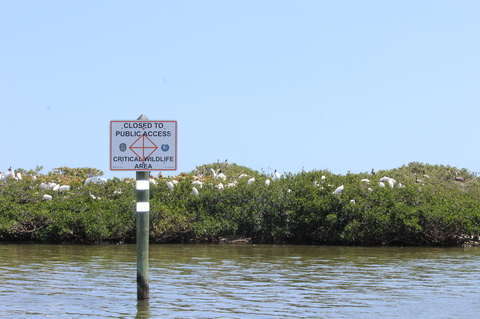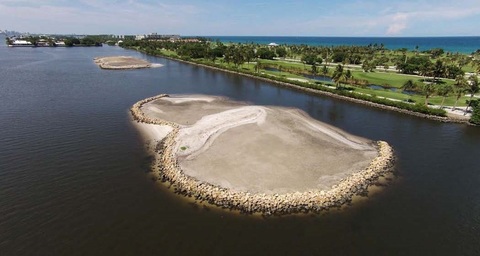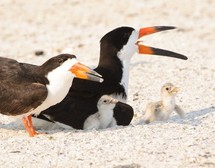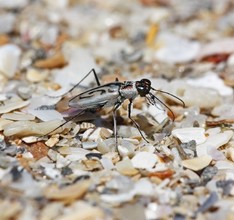|
Welcome to the inaugural edition of Living on the Edge, the newsletter of the Coastal Wildlife Conservation Initiative (CWCI)! This is a quarterly newsletter to update Florida Fish and Wildlife Conservation Commission (FWC) staff, partners and members of the public interested in Florida’s coastal issues about current projects and other points of interest. Regular highlights will include featured projects related to coastal wildlife, interviews with our staff or partners, special seasonal considerations, news and events, and current funding opportunities. If you are interested in spreading the word about your project or someone who is doing a fantastic job in coastal conservation, please contact the CWCI Coordinator, Fara Ilami, at fara.ilami@myfwc.com.
The Coastal Wildlife Conservation Initiative is an FWC-led multi-agency strategy to address threats to coastal wildlife and habitats, while considering human interests and uses of Florida’s coastal areas. The goal is a statewide, cooperative process to protect coastal wildlife populations, conserve and manage coastal ecosystems, and achieve balance between conservation and opportunities for recreation, commercial activities and responsible development.

The Florida Fish and Wildlife Conservation Commission (FWC) is initiating a statewide effort to conserve Florida’s most vulnerable wildlife by establishing Critical Wildlife Areas (CWAs). CWAs are established by the FWC under a Florida Administrative Code rule to protect congregations of one or more species of wildlife from human disturbance during critical life stages such as breeding, feeding or migration. Currently, there are 20 CWAs throughout Florida which are managed for nesting and wintering shorebirds, wading birds, gopher tortoises and bats.
Based on Commission direction at the April meeting, staff began exploring additional sites that may meet the criteria for establishment as new CWAs. In addition, staff have started reviewing existing CWAs to assess possible changes that would enhance the conservation benefits. Staff presented their findings, regarding possible new CWAs and proposed changes to existing CWAs at the June Commission meeting in Apalachicola. Based on Commission direction, staff is further investigating each of the 12 new potential sites and proposed modifications at 5 of the existing sites. Staff is also soliciting public input, including working closely with stakeholders, partners and local governments. Several Public workshops are being held throughout the state to gather this input. At these workshops, the FWC and partners will explain the CWA designation and why it is needed, answer questions and provide opportunity for public comment.
"It is an effort that should be embraced by all who love wild Florida — not just birders, but sportsmen, anglers, photographers, wildlife watchers, paddlers and recreational boaters alike," said FWC Commission Chairman Brian Yablonski. "Florida’s iconic bird species gave birth to the wildlife conservation movement, and those who value wildlife in Florida do well to honor that legacy."
Back to Top
 Photo courtesy of Palm Beach County.
The featured project for this edition is a restoration in Palm Beach County’s Lake Worth Lagoon which created seagrass, salt marsh, mangrove, tidal flat, oyster habitat, and upland coastal habitat. The project site is known as Grassy Flats, a project designed to restore critical marine habitats so that fish, oysters, shorebirds and seabirds could return to the area that was previously uninhabitable because of accumulated muck on the bottom. The Palm Beach County Department of Environmental Resources Management (PBC ERM) designed the project and implemented it in partnership with the Florida Fish and Wildlife Conservation Commission (FWC), the U.S. Fish and Wildlife Service and many other local, state and federal partners.
The Lake Worth Lagoon is the largest estuary in Palm Beach County, and it has accumulated organic (muck) sediment from storm water discharges, resulting in poor water quality and reduced habitat value. The Grassy Flats Project site was selected for restoration due to the 1 to 3 feet of muck covering the area, prohibiting seagrass growth, and its close proximity to Snook Islands Natural Area, another successful restoration project in the central Lake Worth Lagoon. Due to the high volume of muck, estimated to be 30,000 cubic yards in the project area, the site was characterized by low biodiversity and occupied primarily by opportunistic feeding and deposit feeding mollusks.
The objective of the project was to cap nearly 13 acres of shallow water muck sediments with 12 to 18 inches of sand without displacing the muck, in order to provide appropriate sediments, reduce turbidity and improve water quality to create approximately 11 acres of seagrass habitat and 2 acres of intertidal coastal habitat suitable for mangroves, saltmarsh cordgrass, oysters, wading birds and shorebirds.
The site’s shallow water conditions required creative and innovative methods to cap the muck sediments with sand and create valuable coastal habitats. First, 52,000 cubic yards of sand was transported from three different sources to the project site using shallow-water barges mounted with construction equipment and conveyor belts. A high-speed conveyor belt ("Sand Shooter") distributed the sand evenly throughout the project area, "capping" the underlying muck and forming two intertidal islands. Later stages of the project included placing thousands of tons of limestone rock around the man-made islands to protect them and planting thousands of native wetland plants, including saltmarsh cordgrass plugs and red mangrove seedlings.
Portions of the islands were left as open tidal flats and sandy shorelines for coastal birds to forage, and areas of high ground were constructed on each island to provide suitable nesting habitat for American oystercatchers and least terns. This year the FWC and PBC ERM teamed up prior to the nesting season to make these islands more attractive to the birds. Excess vegetation was removed from the islands, and pea gravel and shell hash was placed on the island to provide nesting substrate that would allow the bird eggs to blend in with the ground, thereby providing additional protection from avian predators. Wooden decoys of least terns were also placed on the island to attract the birds to nest. Additionally, signs were placed around the nesting areas warning the public to not enter to avoid disturbing the birds.
 Grassy Flats--North Island, 2016. Photo courtesy of Palm Beach County.
The outcomes of this project were very successful. A pair of American Oystercatchers started nesting on one of the islands even before the project was completed in 2015 and that same pair re-nested in 2016. Ten pairs of least terns nested in 2015 and 31 pairs nested in 2016. In Florida, the American oystercatcher is listed as a Species of Special Concern and the least tern is listed as a Threatened species. Prior to the creation of these islands, least terns had never successfully nested on a beach or island in Palm Beach County. Least terns and other shorebirds and seabirds have nested on tar and gravel roofs of large department stores, warehouses and supermarkets for several years due to the lack of undisturbed and suitable habitat in Florida. Palm Beach County alone had 15 roof nesting colonies in 2016. It is believed that some of the terns nesting on Grassy Flats formerly nested at some of these colonies. The islands and submerged habitat also provide areas for wintering species of birds to feed and rest. Black-bellied plovers, killdeer, ruddy turnstones and many other species of birds have been recorded using these created natural areas. Additionally, manatees have been seen foraging on the saltmarsh cordgrass at high tides. The Florida Fish and Wildlife Research Institute, in partnership with Palm Beach County, is conducting fisheries and oyster monitoring in the Lake Worth Lagoon, with Grassy Flats being one of the monitoring locations, to document the success of the project as it matures.
 Grassy Flats--South Island, 2016. Photo courtesy of Palm Beach County.
Due to the success of this project, the methodology is being used as a model at other sites throughout the Lake Worth Lagoon and beyond. The most interesting part of the methodology for the Grassy Flats project was being able to restore habitat in shallow water muck conditions using shallow water barges and a minimal amount of material over a large area. The methodology can be used to place sand, shell or rock in hard to reach places without using traditional heavy equipment. It could be used to create oyster reefs, to replace sand in eroded areas, or to place sand in areas not easily accessible due to shallow water tidal conditions. Palm Beach County is currently investigating other potential projects to use this methodology as well as traditional methods to restore and enhance shallow estuarine habitats. Other counties, such as Martin, have expressed interest in employing this technique in other estuaries, such as the Indian River Lagoon, to cap muck.
For additional photos of the Grassy Flats Restoration Project, please see the PBC ERM Flickr site.
Back to Top

Shorebirds and seabirds nest on our coastal beaches and islands every year. Many colonies, especially in southwest Florida, were devastated by the storm surge of Tropical Storm Colin in June, which drowned chicks and littered the beach with ruined eggs. Despite these losses, many of these birds are trying to nest again.
In 1980, Florida had 10 million residents. Today, we have 20 million, with another 100 million tourists visiting annually. At the same time, populations of many coastal birds have plummeted.
Each year along Florida's coast, Florida Shorebird Alliance partners (which include FWC and State Park staff, local managers, Audubon Florida staff and volunteers, and others) post many of Florida's beach and island nesting sites to make sure people know where the birds are nesting and to help prevent disturbance. Additionally, volunteer "bird stewards" chaperone nesting colonies on many Florida beaches. These stewards help beachgoers appreciate the breathtaking spectacle of these colonies while reminding people not to get too close to protected areas. Volunteers also help monitor colonies to collect important citizen science data about the birds' nesting efforts.
The birds need your help: to learn about volunteer bird stewarding opportunities, email flconservation@audubon.org for more information.
Summer Beach Tips:
- Respect posted areas, even if you don't see birds inside them. Birds, eggs and nests are well-camouflaged with the beach environment, and disturbance by people can cause the abandonment of an entire colony.
- Give colony islands a wide berth, and when fishing be sure not to leave any equipment behind. Always dispose of fishing line and tackle appropriately, such as in a monofilament recycling bin.
- Avoid disturbing groups of birds. Disturbed birds may take flight, move away from their nests or appear agitated — all of which leave eggs or young susceptible to predators and heat. If birds demonstrate any of these behaviors, you are too close.
- Refrain from walking dogs or allowing cats to roam freely on beaches during the nesting season. Even on a leash, dogs are perceived as predators by nesting birds, causing adults to fly away at even greater distances than people alone.
- Don't let pets off boats onto posted islands or beaches.
- If you are walking your dog on a pet-friendly beach, always keep it on a leash and away from the birds.
- Do not feed gulls or other birds at the beach, or bury or leave trash, picnic leftovers, charcoal or fish scraps on the beach. These scraps attract predators of chicks and eggs, such as fish crows, raccoons, foxes, coyotes and laughing gulls.
- Beach-nesting birds sometimes nest outside of posted areas. If you notice birds circling noisily over your head, "dive bombing" you, or pretending to have a broken wing, you may be near a nest or colony. Leave quietly and enjoy viewing from a distance. Report the sighting to local FWC staff, so that the area can be posted if necessary.
- Most people would never want to hurt baby birds. If you see people disturbing nesting birds, politely let them know how their actions may jeopardize the birds’ survival. If they continue to disturb nesting shorebirds or if you see people entering posted nesting areas, report it to the FWC’s Wildlife Alert Hotline: 888-404-FWCC (3922), #FWC or *FWC on a cell phone, or by texting Tip@MyFWC.com.
Back to Top
|
 1. What is your title? Coastal Wildlife Conservation Initiative (CWCI) Coordinator
2. What organization do you work for? Florida Fish and Wildlife Conservation Commission
3. What type of work do you do? I coordinate actions and communications among our internal CWCI standing team and others involved with coastal wildlife issues, plan and manage different types of projects that benefit coastal wildlife, develop documents and outreach products that address coastal wildlife issues, and maintain a coastal partnership network through working groups, meetings, etc.
4. What project(s) have you recently been working on? Recently I have been working on a project to reduce impacts of mechanical beach cleaning (also called beach raking) on coastal wildlife using a social science technique called Community-Based Social Marketing (CBSM). By emphasizing the importance of beach wrack and vegetation to coastal wildlife, the goal is to change mechanical beach cleaning practices to leave these intact and reduce harm to wildlife. I am also working on developing a training course on living shorelines for marine contractors and one for property owners. The purpose of this is to increase the implementation of softer, more natural approaches to shoreline stabilization, which is beneficial for coastal wildlife, rather than using hardened structures like seawalls and bulkheads. In addition to these main projects, I’ve also been taking some steps to address disturbance of wildlife by dogs on beaches, help promote the expansion of Critical Wildlife Areas, and facilitate usage of vegetation management as a tool to provide habitat for certain types of shorebirds.
5. How long have you been working in the coastal environment, and what are some lessons you have learned? My work in the coastal environment started in the southwest region of the Everglades about 13 years ago and continued through work with Miami-Dade County, graduate school, and work as a Florida Sea Grant Extension Agent before I came into this position. Some lessons I have learned are 1) always plan your fieldwork with the tides and go with at least one partner, 2) often it is necessary to incorporate other fields of knowledge into your work, such as electronics or even carpentry, and 3) sometimes you have to take the plunge into something even when you don’t feel like an expert.
6. What do you think is the greatest threat to coastal ecosystems, and what action(s) should be undertaken to address it? Although there are many threats to coastal ecosystems, I think the greatest is probably destruction of habitat by development, which includes everything from building seawalls to filling wetlands. Some actions that can be taken to address it are incorporating “living shorelines” for shoreline stabilization, purchasing lands for preservation and/or restoration, and ultimately slowing population movement to the coastal zone.
7. What is your favorite coastal animal, and why? I don’t have one favorite coastal animal, but if I had to choose something, I would probably say the green sea turtle. However, I’m also a big fan of invertebrates. Even though they are more marine than coastal, I have a particular affinity for crinoids (also sometimes called sea lilies) for several reasons, including 1) they are relatively rare today, even though they have a rich fossil history, 2) as echinoderms they have pentaradial symmetry (can be divided into 5 similar sections), which is really cool, and 3) they are very beautiful.
8. Do you have a message you would like to share with readers of this newsletter? I would like to encourage readers to reach out to me to share project information and provide feedback on how this newsletter can be used to inform others about what is going on in the world of coastal issues in Florida. I would also encourage recipients to pass the newsletter along, because we are still building our subscriber list.
Back to Top
|
 This summer’s Critter of the Quarter is the white beach tiger beetle, which is most easily seen during the summer season. Florida has two subspecies of this insect, Habroscelimorpha dorsalis media on the Atlantic coast and Habroscelimorpha dorsalis saulcyi on the Gulf coast. Until recently, they were considered part of the genus Cicindela. They can be identified by their pearly color, bronze or black markings (mainly on the Atlantic coast), long legs and large eyes. They range from 0.41 to 0.53 inches in length. There are over 100 species of tiger beetles in North America alone, and there is an entire journal dedicated to their study (Cicindela). Adult white beach tiger beetles may be found in beach wrack, making short flights and feeding on small invertebrates including flies, ants and amphipods, and possibly scavenging on dead fish and crabs. The best time to see them is on a sunny day during summer.
Larvae occur above the high tide line, occasionally in the dunes, as they need a safe place for development. There they hide in burrows with their jaws protruding to catch unwary insects or a variety of small animals of suitable size that come within their reach. Sometimes they retreat deeper into the burrow leaving the entrance hole open, while other times they may actually make a sand plug. For unusually large hurricane tides, the larvae can plug their burrows and wait out occasional inundation. The larva of the Atlantic coast subspecies is notable for its ability to leap into the air, loop its body into a rotating wheel and roll along the sand at a high speed using wind to propel itself. If the wind is strong enough, the larva can move up to 200 feet! This remarkable ability may have evolved to help the larva escape predators. Wheel locomotion in nature is extremely rare and has only been observed in a few animals around the world.
The white beach tiger beetle is most abundant on broad, fine-sand beaches with heavy tidal action and relatively little disturbance by people. For that reason, it has declined on many Florida beaches with vehicle or heavy pedestrian traffic. It is also impacted by development of its habitat, deposition of dredge material and erosion. Other challenges include the construction of groins and bulkheads, which reduce natural movement of sand and suitability for these tiger beetles. They are not currently listed as endangered or threatened, but reassessment may be necessary in the future due to current downward trends in related species. The Atlantic subspecies historically ranged from southern New Jersey to Miami, but its range has been diminished at both extremes, and now it is scarcely found south of the Daytona area.
Efforts to save threatened least terns on our public beaches also contribute to an environment suitable for tiger beetles. This effort is largely fencing off tern nesting areas and informing the public about the necessity to protect the terns. Actions to protect dunes such as limiting pedestrian traffic in dunes and preventing sea oats collection, contribute to a good habitat for these beetles. Discouraging use of sea walls and groins on beaches to allow more natural movement of sand also contributes to conservation of these beetles and other coastal wildlife.
Back to Top
|
U.S. Fish and Wildlife Service 2016 Candidate Conservation Action Funds — The overall goal of this funding opportunity is based on cooperative relationships with states, non-profit organizations, private landowners and those interested in habitat restoration or undertaking candidate and at-risk species research, surveys and monitoring, or educational outreach efforts. Work may be done via grant agreement, project grants, or direct payment for specified use. Search grants.gov for F16AS00100. Applications are due by July 31, 2016. However, you may submit applications throughout the year. Consideration of applications ultimately will be based on the FWS budget cycle.
NOAA National Marine Fisheries Service Coastal Ecosystem Resiliency Grants Program — This opportunity is focused on projects that use a proactive approach to improving or restoration coastal habitat to: (1) strengthen the resilience of marine and coastal ecosystems and decrease the vulnerability of communities to extreme weather, and (2) support sustainable fisheries and contribute to the recovery of protected resources. Proposals are due August 16, 2016.
National Academy of Sciences Gulf Research Program, Enhancing Resilience and Well-being in Gulf Region Coastal Communities: A Grants Program of the Gulf Research Program in Collaboration with the Robert Wood Johnson Foundation — This funding opportunity seeks to enhance the resilience of Gulf region communities to the negative impacts of environmental change in ways that also improve health and well-being, and promote health equity. Proposed projects should seek to improve both the science and the practice of resilience by engaging integrative teams in the development of rigorous and actionable information and the testing and evaluation of strategies at a community-level. The Letter of Intent is due October 5, 2016.
U.S. Fish and Wildlife Service North American Wetlands Conservation Act NAWCA Grants, U.S. Small Grants — The NAWCA program provides matching grants to wetlands conservation projects. The U.S. Small Grants deadline is November 3, 2016.
Back to Top
|